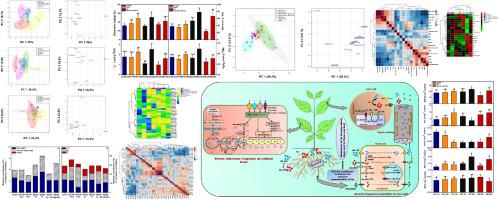Journal of Hazardous Materials ( IF 12.2 ) Pub Date : 2020-07-02 , DOI: 10.1016/j.jhazmat.2020.123368 Monika Patel 1 , Asish Kumar Parida 1

|
Heavy metal(loid)s contamination in soil is a major environmental concern that limits agricultural yield and threatens human health worldwide. Arsenic (As) is the most toxic non-essential metalloid found in soil which comes from various natural as well as human activities. S. persica is a facultative halophyte found abundantly in dry, semiarid and saline areas. In the present study, growth, mineral nutrient homeostasis, MDA content, phytochelatin levels, and ROS-scavenging attributes were examined in S. persica imposed to solitary treatments of salinity (250 mM and 750 mM NaCl), solitary treatments of arsenic (200 μM and 600 μM As), and combined treatments of As with 250 mM NaCl with an aim to elucidate salinity and As tolerance mechanisms. The results demonstrated that S. persica plants sustained under high levels of As (600 μM As) as well as NaCl (750 mM). The activity of superoxide dismutase, catalase, peroxidase, and glutathione reductase were either elevated or unaffected under salt or As stress. However, ascorbate peroxidase activity declined under both solitary and combination of As with NaCl. Furthermore, the cellular redox status measured in terms of reduced ascorbate/dehydroascorbate, and reduced glutathione/oxidized glutathione ratios also either increased or remained unaffected in seedlings treated with both solitary and combined treatments of As + NaCl. Significant accumulation of various oxidative stress indicators (H2O2 and O2−) were observed under high As stress condition. However, presence of salt with high As significantly reduced the levels of ROS. Furthermore, exogenous salt improved As tolerance index (Ti) under high As stress condition. The values of translocation factor (Tf) and As bioaccumulation factor (BF) were >1 in all the treatments. From this study, it can be concluded that the facultative halophyte S. persica is a potential As accumulator and may find application for phytoextraction of arsenic-contaminated saline soil.
中文翻译:

盐度通过调节生理,生化和ROS清除属性来减轻兼性盐生植物Salvadora persica L.中的砷毒性。
土壤中的重金属(金属)污染是主要的环境问题,它限制了农业产量并威胁着全世界的人类健康。砷(As)是在土壤中发现的最具毒性的非必需类金属,它来自各种自然活动以及人类活动。波斯菊是一种兼性的盐生植物,在干燥,半干旱和盐碱地区大量发现。在本研究中,研究了对盐渍化(250 mM和750 mM NaCl的单独处理),砷(200μM的单独处理)施加的S. persica中的生长,矿物质营养稳态,MDA含量,植物螯合素水平和ROS清除特性。和600μMAs),并与250 mM NaCl联合处理As,以阐明盐度和As耐受机制。结果表明波斯菊植物在高水平的As(600μMAs)和NaCl(750 mM)下持续生长。在盐或砷胁迫下,超氧化物歧化酶,过氧化氢酶,过氧化物酶和谷胱甘肽还原酶的活性升高或不受影响。但是,在单独和As与NaCl混合作用下,抗坏血酸过氧化物酶活性均下降。此外,以抗坏血酸盐/脱氢抗坏血酸盐减少以及谷胱甘肽/氧化型谷胱甘肽比率降低来衡量的细胞氧化还原状态在单独和联合处理As + NaCl处理的幼苗中也增加或保持不受影响。各种氧化应激的指标显著积累(H 2 ö 2和O 2 - )在高砷胁迫条件下观察到。但是,高砷盐的存在会显着降低ROS的水平。此外,外源盐在高As胁迫条件下改善了As耐性指数(T i)。在所有处理中,转运因子(T f)和砷生物积累因子(BF)的值均> 1。从这项研究可以得出结论,兼性盐生植物S. persica是一种潜在的As积累剂,可能会在砷污染的盐渍土壤的植物提取中找到应用。











































 京公网安备 11010802027423号
京公网安备 11010802027423号